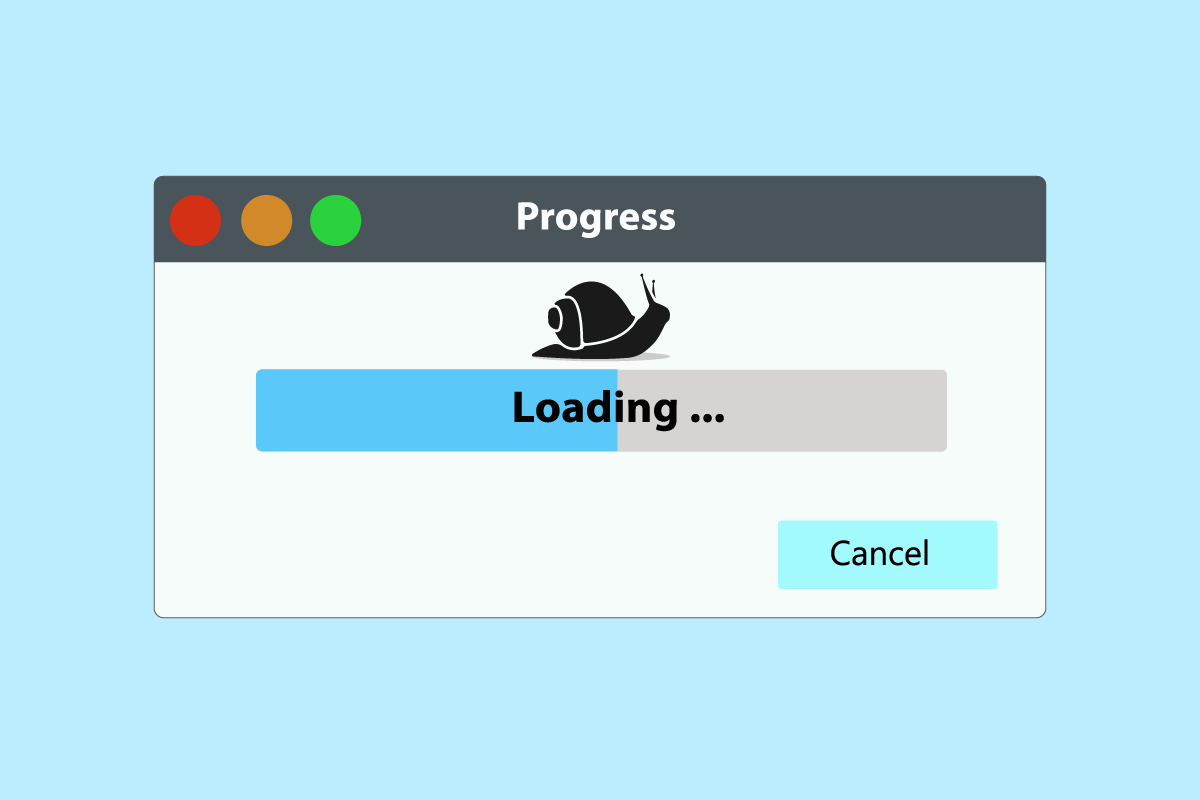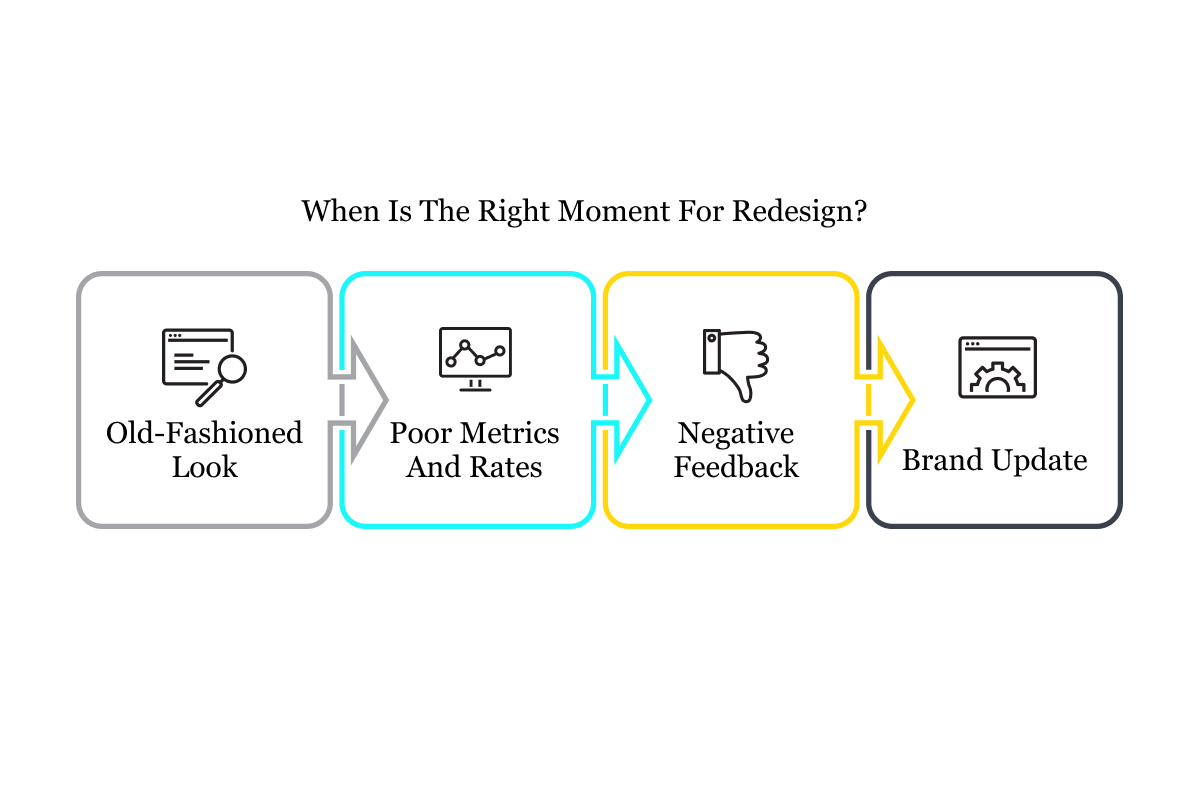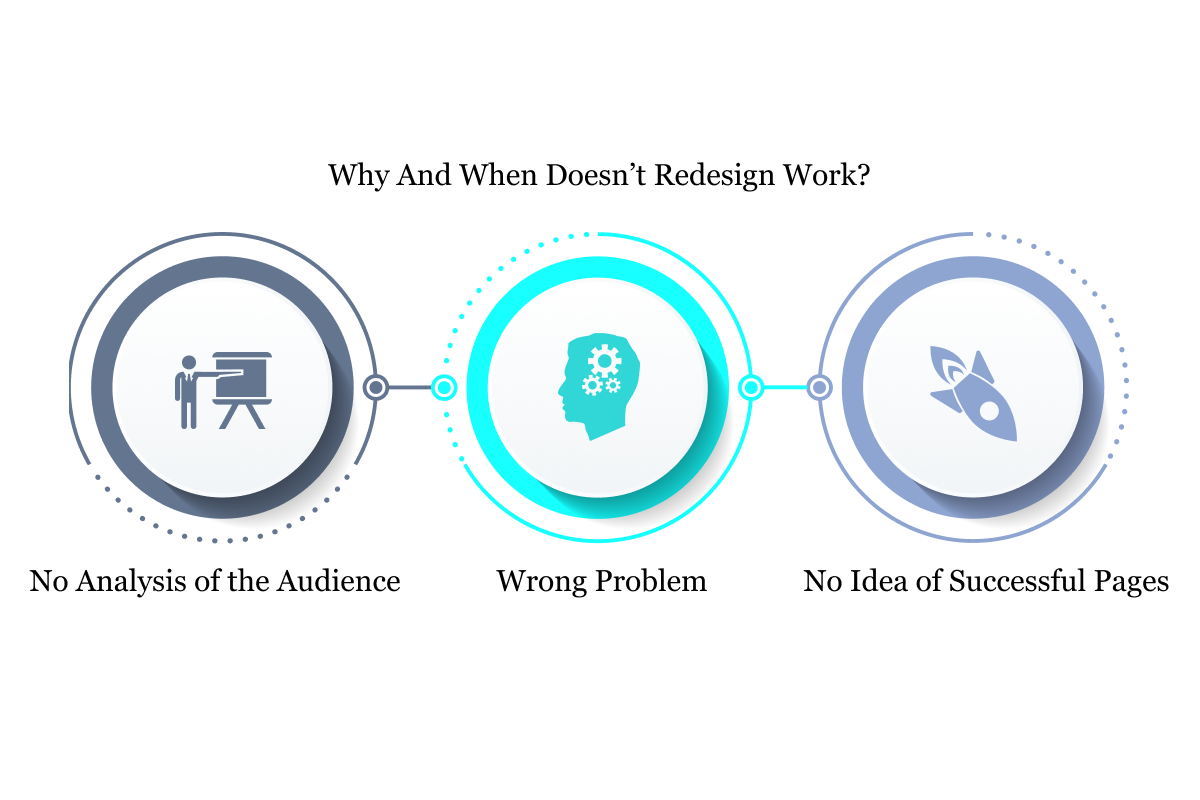The website is the face of your brand. Its design should present your business at its finest to both existing and potential customers. The site has to evolve and change over time, like the rest of the online world, to stay fresh and captivating for customers.
The digital world is constantly changing, and businesses need to quickly adapt to new demands and trends to stay relevant. So, even if there is a perfect website, it requires a regular revamp. Moreover, by deploying new technologies for your design, you can outdo competitors and attract more consumers.
When do you need to redesign a website? When it’s outdated, poorly designed, has ineffective content, and so on. Read on to learn more about the benefits of a website redesign, and discover our list of 11 steps to a successful revamp.
What is Website Redesign?
Let’s get right to the definition. Website redesign is the process of refreshing and modernizing a website to improve the user experience and appeal to target customers with less friction. By adjusting the functionality and look of the existing website, companies seek to increase conversion rates, optimize speed and performance, and ensure that the website works optimally on all devices, browsers, and operating systems.

Redesign usually involves changes to the front-end (visual elements and color schemes) and back-end (functionality, code, accessibility, and usability). Every 3 to 5 years, it’s recommended to make a revamp to follow the ever-changing trends and technologies. How long does it take to redesign a website? It typically takes 30-90 days to do so from scratch, depending on the project. Complex revamp is a time- and resource-consuming process, but if you do it regularly and properly, it’ll help your business ensure higher customer satisfaction, automate sales and retain clients.
If you look at the most famous website redesign examples like Instagram, Twitter and Reddit, you can see how well-thought-out changes can change the entire look of the brand and make a site more visually attractive and user-friendly.
11 Steps to Start Redesign
How to start a website redesign? When it’s time for a revamp, it’s a bad choice to cut corners and skip steps. To make sure nothing goes wrong, you should invest enough time and resources to increase conversion rates and improve ROI.
Start with proper planning and research and follow our 11-step website redesign roadmap to transform your website into a conversion-optimized business tool:

1. Make an audit of your current website
If you’ve decided to tackle your website redesign, the first thing you need to do is a plan. How thorough you are in this phase will determine how successful your project will be. Start with an in-depth audit of your website. You can divide the process into the following steps:
-
Evaluate a website’s page performance
First things first, you need to create a sitemap of your current website and then analyze each page for performance: this way you can identify certain user trends. Analyze key metrics — conversions, bounce rates, and traffic — to find out which pages are the most popular and useful, which ones are missing, and which ones you can delete.
In a nutshell, if you analyze the metrics, you’ll know which pages you need to revise and update.
-
Make an SEO audit
An SEO or search engine optimization audit is the process of analyzing your website and evaluating numerous factors that contribute to your ranking in search engine results. This allows you to identify issues such as page load speed or missing keywords that negatively impact your performance in an organic search.
With an SEO audit, you can:
— make sure that your website is crawled and indexed correctly by Google;
— optimize your content with keywords;
— identify on-page SEO errors;
— detect off-page SEO errors;
— ensure your website provides a good user experience;
— eliminate duplicate pages on your website.
Platforms like Google Search Console and Semrash are effective tools for analyzing your website.
-
Assess the website’s copy
Review your website’s copy. Is it useful? Does it help consumers solve their problems? If the answer is no, there is a lot to do. The content needs to be revised so that the focus is no longer on self-promotion, but on solving users’ problems. When revising your copy, check if it covers all stages of the customer journey. It’s better to know the path that potential customers take when visiting your website to give them what they want.
2. In-depth research of the user journey
At this stage, it’s a good idea to create a user journey map — the user’s path through your website on their way to purchase. It should focus on the actions and emotions customers experience when using your site. This will help you understand what your clients are looking for, what they want to know, how they interact with your website, and what pages they open in searching for the information they need. Be sure to identify gaps in the user journey — this will help you close them in the future.
To make your website more interactive and user-friendly, you can conduct customer surveys. Talk to your customers and ask them about their experience. These can be questions like:
- Why did you buy our product?
- Was there anything on the site that made it difficult to navigate?
- Were you able to easily find everything you were looking for on the site?
User testing is another effective way to learn firsthand how users interact with your site and where they encounter friction. This method involves asking your potential customers to complete various tasks on your website. For this purpose, you can use services like Userlytics, UserTesting and Hotjar. They will help you find out where users end their journey, which pages they open most frequently, and if there are any bugs.
3. Setting goals
At this stage, it’s crucial to set specific and realistic goals. Since the website redesign process takes a lot of money and effort, bringing results is a must. So take your findings from the website audit, distinguish the areas that need improvement, and develop a strategy based on that. Involve the whole team to brainstorm and set measurable and feasible goals for your website (e.g., increase conversion rate by 2% in 10 months).
4. Create a thorough website redesign strategy
Once you understand the current performance of your website, you should set clearly defined goals. To achieve them, you need to develop a strategy that includes the following:
-
- Updated sitemap. A sitemap is a visual representation of your website that helps you get an overview of the hierarchy of pages and reorder them. Look at your audit and determine the pages which perform well, which are less popular, and which are redundant. Then it’s time to delete the old ones and add new ones that are still missing on your website.
- Ideal user flow. A well-crafted user flow is one way to show consumers the specific steps they need to take to make a purchase. Ease their path as they interact with your site. This way, you’ll get more quality leads.
- Keyword research. This is a crucial step in understanding what your visitors are looking for. Find out the terms they are searching for and use them in your website content. For this purpose, you can use tools like Semrush and Keyword Magic, which will save you a lot of time.
- Messaging strategy. First, you need to know what your message is, then review your website. Does it convey the message clearly? If not, it’s high time you work on website improvement and make sure that every single page reflects the message to your visitors. Let them know how exactly you can help.
5. Set a realistic timeline
This takes much time to create a functional website that drives leads. Therefore, when building your website redesign strategy, don’t try to do everything as quickly as possible. Take your time and don’t rush the important steps to achieve the quality you want. There’s no specific timeline, but it usually takes a couple of months, depending on how comprehensive your website is and how much improvement is required. After you decide on a preferred timeline, break it down into smaller sprints with set milestones.
6. Create or update the brand style guide
One of the most effective, but often overlooked, website redesign considerations is updating your brand style guide. If you don’t have it yet, you should seriously consider creating one. This is the image people see when they think of your business and what you represent. By updating your brand style, you’ll ensure that what your brand says and wants to say are the same message. First and foremost, you need to understand who you are and what you’re selling to align your messaging with that. Then you have to make sure that the visual elements of your brand, including typography, color palette, logo, etc., reflect who you are.
7. Do a competitive analysis
Take a close look at your competitors’ websites and note what strategies they use, what they do right and wrong, and what their sites look like. This way, you will get a sense of industry standards and how to meet customers’ needs. Analyzing your competitors can help you find inspiration and identify opportunities for improvement while redesigning your website.
8. Create content that aligns with updates
This takes a massive amount of work, but it’s worth it. When following website redesign steps, make sure your actions don’t come at the expense of your high-performing content. Removing pages that drive a lot of traffic and contain many inbound links can undermine your marketing efforts. Instead, focus on pages with poor results and create content wireframes that help your visitors find the answers they are looking for. This is crucial because it is a type of content that makes customers come back.
9. Design the website
Once the previous stages are complete, it’s time to proceed to web design. Start by creating wireframes that show how your content will be arranged on each page so you can see the site’s structure and then move on to the homepage redesign and then the other pages. This approach will save you time-consuming revisions and help you develop an engaging website that will drive more visitors and quality leads.
10. Develop the website
Once you’re done with the design, you can finally start with the website development. At this stage, take enough time to code your website clearly and follow the best SEO and marketing practices. When transferring your flat design mockups, you should also check cross-browser functionality to improve the experience for all users. Ensure that regardless of what browser they use, your website will be displayed the way it’s supposed to.
11. Test & launch your website
Last but not least, it’s testing and launching your website. First, you need to do a pre-launch check to make sure everything performs properly. This includes checking if there are any broken links, if all meta descriptions and page titles are correct, and if there are no broken images. After launch, verify that all pages are rendering correctly and that your analytics are in order.
Why Is Regular Website Redesign Important?
In the competitive world of business, an eye-pleasing, user-friendly and responsive website will determine your success. Before your potential customers call you and buy your services, they research, review your website and online presence, and compare you to the competitors. It only takes 50 milliseconds for a customer to decide whether to stay on or leave your website. Thus, you must grab their attention right away.

One of the most vital website redesign benefits is that you can keep up with industry trends and outdo your competitors. If you notice that the number of visitors is decreasing and your website looks outdated, it’s a clear sign that you need to change something.
How Often Should You Redesign Your Website
Redesigning a website is a time-consuming and resource-intensive process, but the rewards are immense: satisfied users, improved lead generation, and increased revenue. Since your website is always up and running, you have to make sure its performance is effective. Review your website, and if you notice something is off, consider revamping it. To tell if it’s the right time to redesign your website, check the following signs:

-
Old-Fashioned Look
The functionality of your website is important, but so are the visuals. The visual appearance of your site defines how your users see your brand and associate it with the quality of your products or services. If it’s cluttered with hyperlinks, has poorly scaled images and too much text, it may neither perform well nor bring in more visitors.
Visit your competitors’ sites. How modern do they look? How do your competitors achieve this? What visuals do they use? Then you can try to apply these insights to your brand. Make sure that the first impression visitors get of your brand is great, and you can do that by redesigning your website.
-
Unsatisfying Metrics And Rates
If you notice your website is losing traffic and has higher bounce rates and lower conversions, you should consider a website refresh. Metrics tell you whether your website is providing an engaging experience for your visitors and delivering the information they’re looking for. For example, a bounce rate shows that a user leaves the site after visiting only one page, which means they didn’t explore the content further because they weren’t interested. The conversion rate determines whether a user performs the desired action on your website. If this parameter is low, your website isn’t attractive enough to motivate them to take actions.
-
Negative User’s Feedback
88% of users do not come back to a website after a bad experience. It’s crucial to get feedback from customers, even if it’s negative. It tells you what is not working on your website and causing friction. If you find that more and more users are dissatisfied with their experience, it’s time for a revamp. Collect negative feedback and use it to make future improvements.
-
Brand’s Update
There can be many reasons why you decide to rebrand. For instance, you may want to reposition your brand message or align the visual and textual message you’re conveying. A deep rebranding usually requires conceptual changes, content refresh, additional features and UI / UX in line with industry trends.
Ways to Know Your Web Design Isn’t Working
You may have high hopes for your website overhaul. But you should know that there is a scenario in which the process won’t help you achieve the set goals. Therefore, before you start redesigning your website, you should plan it thoroughly in order to get results and not go over budget and timeline. And here are the mistakes you should avoid while creating a site with solid performance:

-
You Didn’t Analyse The Audience
We’ve already mentioned that analyzing the target audience will help you address and fulfill customer needs. In this way, more and more users will become your clients. If you misidentify your target audience, it can hurt your entire website redesign plan. You may want to reach the widest possible audience, but then your potential customers probably won’t find what they’re looking for. Instead, define your buyer persona and create a website that meets their needs.
-
You Didn’t Figure Out Which Pages Are Important
Find out which pages on your site work and which don’t. There are definitely pages that have high traffic and a good conversion rate. You should focus on them and make sure they remain safe and stable when you redesign your website. Besides, there are pages that don’t perform as well. Look at where users usually leave your site and find out which pages require redesign or even elimination. In any case, don’t blindly redesign everything, as this can be a reason you lose leads.
-
You Didn’t Get The Problem Right
When it comes to website redesigning tips, define certain problems to solve. The reason should simply be that you are tired of the current design. There should be evidence that the website doesn’t perform the way you expect it to. Analyze your metrics, and if there are some basic issues, only then start revamping your site. After a thorough investigation, you may find out that a complete redesign isn’t necessary at all, and you just need to make a small improvement. This is important because the website redesigning process is time-consuming and laborious. If you start it without a solid reason, you may get not positive results, but decreased performance.
Wrapping Up
Do you think it is the right time to start a redesign? We hope that after reading this article, you know for sure whether you need it or not. It’s a process that takes a lot of time, money, and effort, but the results are all worth it. When you are ready to website refresh, be sure to devote enough resources to do it correctly. Do thorough research first, analyze your business goals, develop a well-thought-out strategy, and finally create an easy-to-navigate and eye-catching website to attract more customers and achieve positive results for your business.
Whether you know something about a website redesign or not, it’s always better to hire professionals to do it. The team at LITSLINK has helped 80+ startups grow and knows exactly how to upgrade websites and make them more attractive to users. If you need any help, feel free to get in touch!




